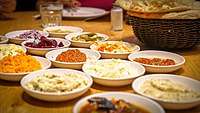Maghrebi mint tea
Maghrebi mint tea (Arabic: الشاي المغربي بالنعناع, romanized: aš-šhāy al-maghrebi bin-na'nā';[1] Maghrebi Arabic: أتاي, romanized: atay; Berber languages: ⴰⵜⴰⵢ, romanized: atay), is a green tea prepared with spearmint leaves and sugar, traditional to the Greater Maghreb region (the northwest African countries of Morocco, Algeria, Tunisia, Libya, and Mauritania). It has since spread throughout North Africa, parts of the Sahel, France and the Arab world. It is most closely associated with Morocco and in Spanish is known simply as "Moorish tea", té moruno. A similar drink is prepared in Spain but is typically served chilled as iced tea in the summer, instead of hot year-round.

Mint tea is central to social life in the Maghreb.[2] The serving can take a ceremonial form, especially when prepared for a guest. The tea is traditionally made by the head male in the family and offered to guests as a sign of hospitality. Typically, at least three glasses of tea are served[3] The tea is consumed throughout the day as a social activity.[4][5][2] The native spearmint Nana possesses a clear, pungent, mild aroma, and is the mint that is traditionally used in Maghrebi mint tea. Other hybrids and cultivars of spearmint, including yerba buena, are occasionally used as substitutes for Nana mint. In Morocco, mint tea is sometimes perfumed with herbs, flowers, or orange blossom water. In the cold season, they add many warming herbs like pennyroyal mint and wormwood.[2]
History
Gunpowder tea was introduced into North Africa by the British in the 18th and 19th centuries via Morocco and Algeria.[6] James Richardson recorded a description of a Moroccan tea ceremony in the 1840s, and said that during his travels tea was drunk widely and all day long.[4] During the Crimean War in the 1850s, the British East India Company diverted tea meant for the Baltic states to Morocco, leading to a further increase in the availability of tea.[2] By the early 20th century, mint tea had become well established in Morocco.[5]
Preparation

The basic ingredients of the tea are green tea, fresh mint leaves, sugar, and boiling water.[2] The proportions of the ingredients and the brewing time can vary widely. Boiling water is used in the Maghreb, rather than the cooler water that is used in East Asia to avoid bitterness. The leaves are left in the pot while the tea is consumed, changing the flavor from one glass to the next.
It is poured into glasses from high above to swirl loose tea leaves to the bottom of the glass, whilst gently aerating the tea to improve its flavor.
In the winter, if mint is rare, sometimes leaves of tree wormwood (chiba or sheeba in Moroccan dialect) are substituted for (or used to complement) the mint, giving the tea a distinctly bitter flavor.[7] Lemon verbena (louiza in Moroccan arabic) is also used to give it a lemon flavor. The tea is sometimes sold as a ready-to-cook mixture of tea and dried mint, which is easier to store and to prepare but has diminished flavor.
A simple and practical method runs as follows:
- In a teapot, combine two teaspoons of tea-leaf with a half liter of boiling water. Allow it to steep for at least 15 minutes.
- Without stirring, filter the mixture into a stainless steel pot, so that the tea leaves and coarse powder are removed.
- Add sugar (about one teaspoon per 100 milliliters).
- Bring to boil over a medium heat (this helps the sugar dissolve).
- Fresh mint leaves can be added to the teapot, or directly to the cup.
A more complex method is as follows:
The tea is first put in the teapot and a small quantity of boiling water is added. The tea is left to infuse for approximately 20–30 seconds. This initial liquid is poured out and kept aside. This is the "spirit" of the tea and will be added back after the tea is washed, to restore the "spirit" (the "spirit" of the tea is essentially a strong, deeply flavored liquid from the initial infusion, which adds extra flavor to the final infusion). The tea is then "cleaned" by adding a small quantity of boiling water; that is poured out after one minute (to lessen the bitterness). This process may be repeated more than once. Mint and sugar are added (amounts vary; approximately five teaspoons of sugar for one teaspoon of tea leaves is typical), and water at the boiling point is then poured in the pot. The pot may then be taken to heat and further boiled to increase the flavor of the infusion. After three to five minutes, a glass is served and poured back in the pot two to three times to mix the tea. Tea is then tasted (sugar if needed may be added) until the infusion is fully developed.
Traditionally, the tea is served three times. The amount of time it has been steeping gives each of the glasses of tea a unique flavor, described in this famous Maghrebi proverb:
The first glass is as gentle as life,
the second is as strong as love,
the third is as bitter as death.[2]
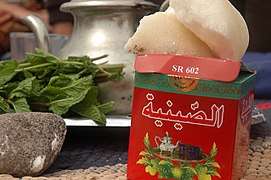 Ingredients.
Ingredients.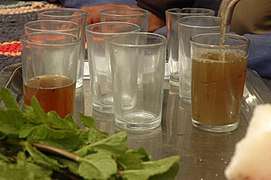 Cleaning the tea.
Cleaning the tea.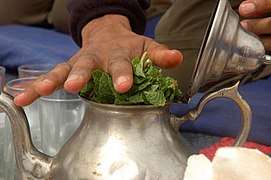 Adding the mint.
Adding the mint.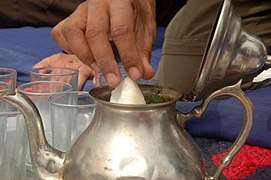 Adding the sugar.
Adding the sugar. Ready to drink.
Ready to drink.
See also
References
- هي, مجلة (2020-02-24). "ما هي فوائد الشاي المغربي". مجلة هي (in Arabic). Retrieved 2020-03-17.
- "Tea in Morocco: 'It's in the blood'". 2014-10-21. Retrieved 2019-06-09.
- "Authentic Moroccan Mint Tea Recipe (from my Mother Cookbook)". Moroccan Zest. 2018-05-29. Retrieved 2018-09-19.
- Richardson, James (1860). Travels in Morocco. Charles J. Skeet.
- Wharton, Edith (1920). In Morocco. Oxford: JB. ISBN 1515420566.
- Ken Albala (2011). Food Cultures of the World Encyclopedia. ABC-CLIO. p. 235. ISBN 978-0-313-37626-9.
- Artemisia: An Essential Guide from The Herb Society of America (PDF), The Herb Society of America, 2013, archived from the original (PDF) on 2015-09-05
